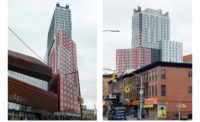The structural performance of a single-story, wood-stud frame with brick veneer during a Jan. 26 shake-table test at the University of California, San Diego, offered no surprises. However, the structure’s masonry veneer showed distress in places, and that did surprise researchers. The full-scale earthquake test was the first of two designed to help engineers use performance-based design to improve the seismic behavior of masonry and wood buildings, common in residential and light-commercial construction.
“We believe that under many circumstances veneer can help structural performance,” says Richard E. Klingner, professor of civil engineering at the University of Texas, Austin, and the principal investigator.
Researchers shook the structure to two times the maximum considered earthquake (MCE), and it did not fail. But the team is a bit perplexed by the veneer distress. “We are trying to figure out the underlying reasons for what we saw,” says Klingner.
The $950,000 program is a collaboration between UT, UC San Diego, Washington State University and North Carolina Agricultural and Technical State University. The National Science Foundation and the National Concrete Masonry Association are the program’s sponsors.
Researchers subjected the structure to shaking representing magnitude-5 to magnitude-9 quakes. Parts of the structure showed veneer distress under shaking consistent with the design-basis earthquake for zones of high seismicity. Other parts showed distress only at shaking in excess of the MCE.
Researchers are examining the data to develop refinements to design and construction provisions for masonry veneer. They will test a frame with concrete masonry veneer in the second half of March.











Post a comment to this article
Report Abusive Comment